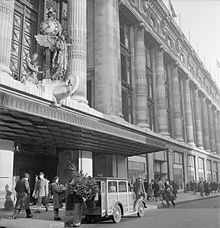First American department stores (1825–1858)[edit]
Arnold Constable was the first American department store. It was founded in 1825 as a small dry goods store on Pine Street in New York City. In 1857 the store moved into a five-story white marble dry goods palace known as the Marble House. During the Civil War, Arnold Constable was one of the first stores to issue charge bills of credit to its customers each month instead of on a bi-annual basis. The store soon outgrew the Marble House and erected a cast-iron building on Broadway and Nineteenth Street in 1869; this “Palace of Trade” expanded over the years until it was necessary to move into a larger space in 1914. Financial problems led to bankruptcy in 1975.
[21]
In New York City in 1846,
Alexander Turney Stewart established the "
Marble Palace" on
Broadway, between Chambers and Reade streets. He offered European retail merchandise at fixed prices on a variety of dry goods, and advertised a policy of providing "free entrance" to all potential customers. Though it was clad in white marble to look like a
Renaissance palazzo, the building's
cast iron construction permitted large
plate glass windows that permitted major seasonal displays, especially in the Christmas shopping season. In 1862, Stewart built a new store on a full city block uptown between 9th and 10th streets, with eight floors. His innovations included buying from manufacturers for cash and in large quantities, keeping his markup small and prices low, truthful presentation of merchandise, the one-price policy (so there was no haggling), simple merchandise returns and cash refund policy, selling for cash and not credit, buyers who searched worldwide for quality merchandise, departmentalization, vertical and horizontal integration, volume sales, and free services for customers such as waiting rooms and free delivery of purchases.
[22] In 1858,
Rowland Hussey Macy founded
Macy's as a dry goods store.
Innovations 1850-1917[edit]

Marshall Field's State Street store "great hall" interior around 1910
Marshall Field & Company originated in 1852. It was the premier department store on the busiest shopping street in the Midwest at the time,
State Street in Chicago.
[23] Marshall Field's served as a model for other department stores in that it had exceptional customer service.[
citation needed] Marshall Field's also had the firsts; among many innovations by Marshall Field's were the first European buying office, which was located in Manchester, England, and the first bridal registry. The company was the first to introduce the concept of the personal shopper, and that service was provided without charge in every Field's store, until the chain's last days under the Marshall Field's name. It was the first store to offer revolving credit and the first department store to use
escalators.[
citation needed] Marshall Field's book department in the State Street store was legendary;[
citation needed] it pioneered the concept of the "book signing". Moreover, every year at Christmas, Marshall Field's downtown store windows were filled with animated displays as part of the downtown shopping district display; the "theme" window displays became famous for their ingenuity and beauty, and visiting the Marshall Field's windows at Christmas became a tradition for Chicagoans and visitors alike, as popular a local practice as visiting the Walnut Room with its equally famous Christmas tree or meeting "under the clock" on State Street.
[24]
In 1877,
John Wanamaker opened what some claim was the United States' first "modern" department store in
Philadelphia: the first to offer fixed prices marked on every article and also introduced electrical illumination (1878), the telephone (1879), and the use of pneumatic tubes to transport cash and documents (1880) to the department store business.
[25]
 Selfridges
Selfridges,
Oxford Street in
London, 1944
Another store to revolutionize the concept of the department store was
Selfridges in London, established in 1909 by American-born
Harry Gordon Selfridge on
Oxford Street. The company's innovative marketing promoted the radical notion of shopping for pleasure rather than necessity and its techniques were adopted by modern department stores the world over. The store was extensively promoted through paid advertising. The shop floors were structured so that goods could be made more accessible to customers. There were elegant restaurants with modest prices, a library, reading and writing rooms, special reception rooms for French, German, American and "Colonial" customers, a First Aid Room, and a Silence Room, with soft lights, deep chairs, and double-glazing, all intended to keep customers in the store as long as possible. Staff members were taught to be on hand to
assist customers, but not too aggressively, and to
sell the merchandise.
[26] Selfridge attracted shoppers with educational and scientific exhibits; in 1909,
Louis Blériot's
monoplane was exhibited at Selfridges (Blériot was the first to fly over the
English Channel), and the first public demonstration of television by
John Logie Baird took place in the department store in 1925.
 Utagawa Hiroshige
Utagawa Hiroshige designed an
ukiyo-e print with
Mount Fuji and Echigoya as landmarks. Echigoya is the former name of Mitsukoshi named after the
former province of Echigo. The Mitsukoshi headquarters are located on the left side of the street.
In
Japan, the first "modern-style" department store was
Mitsukoshi, founded in 1904, which has its root as a
kimono store called Echigoya from 1673. When the roots are considered, however,
Matsuzakaya has an even longer history, dated from 1611. The kimono store changed to a department store in 1910. In 1924, Matsuzakaya store in
Ginza allowed street shoes to be worn indoors, something innovative at the time.
[27] These former kimono shop department stores dominated the market in its earlier history. They sold, or instead displayed, luxurious products, which contributed to their sophisticated atmospheres. Another origin of the Japanese department store is from
railway companies. There have been many
private railway operators in the nation and, from the 1920s, they started to build department stores directly linked to their lines'
termini.
Seibu and
Hankyu are typical examples of this type.









 Thank you Bird Jaguar.
Thank you Bird Jaguar.



